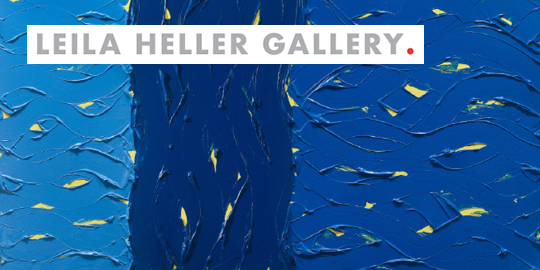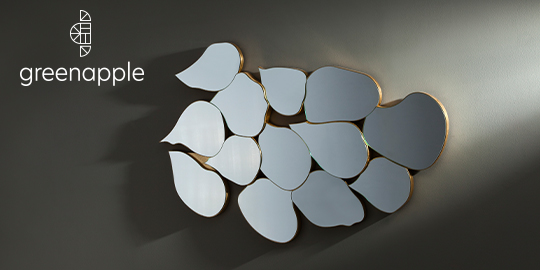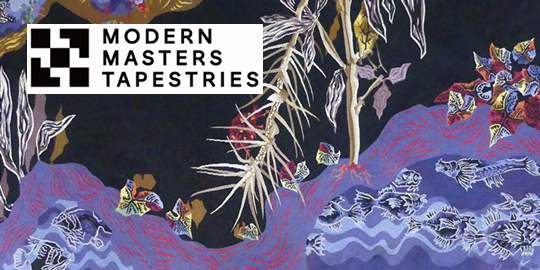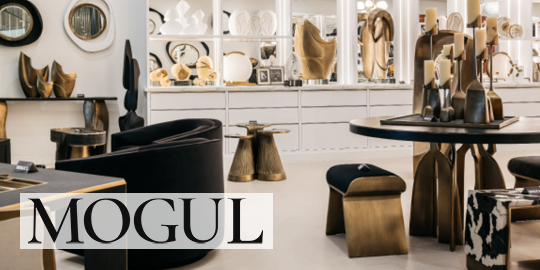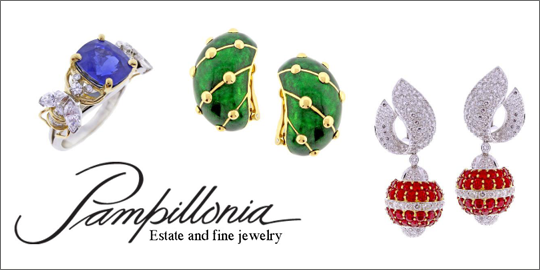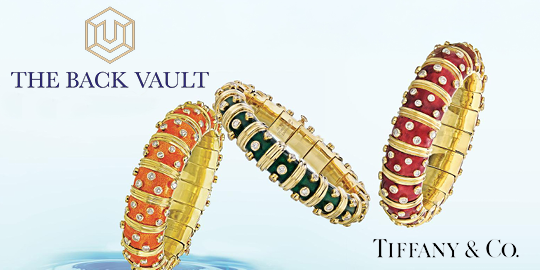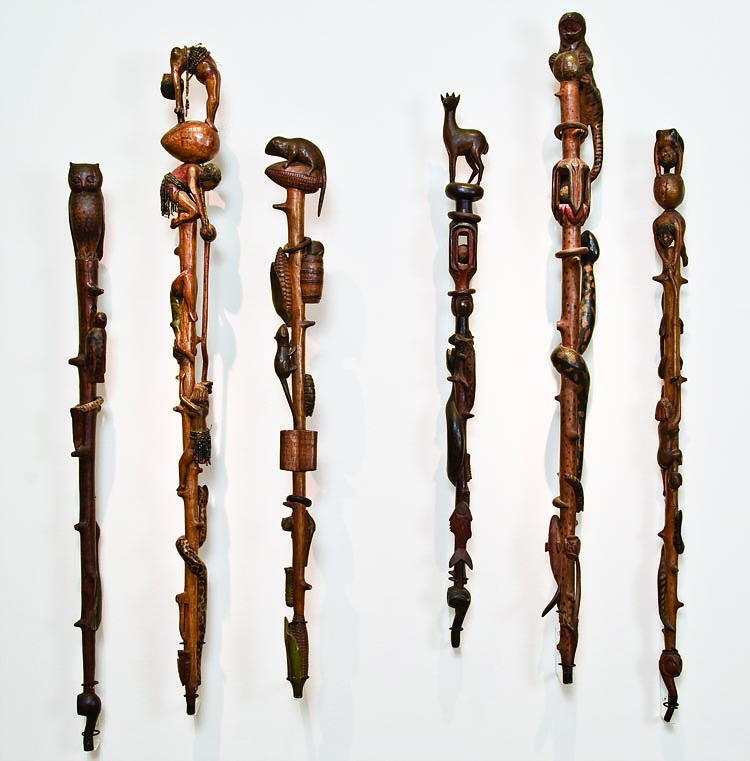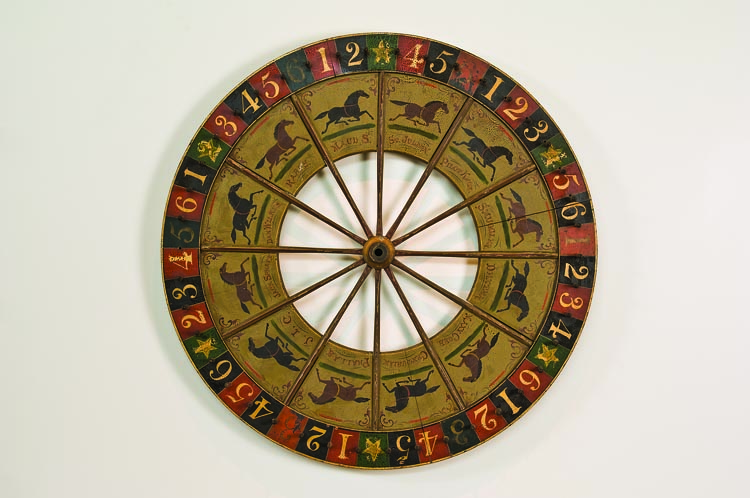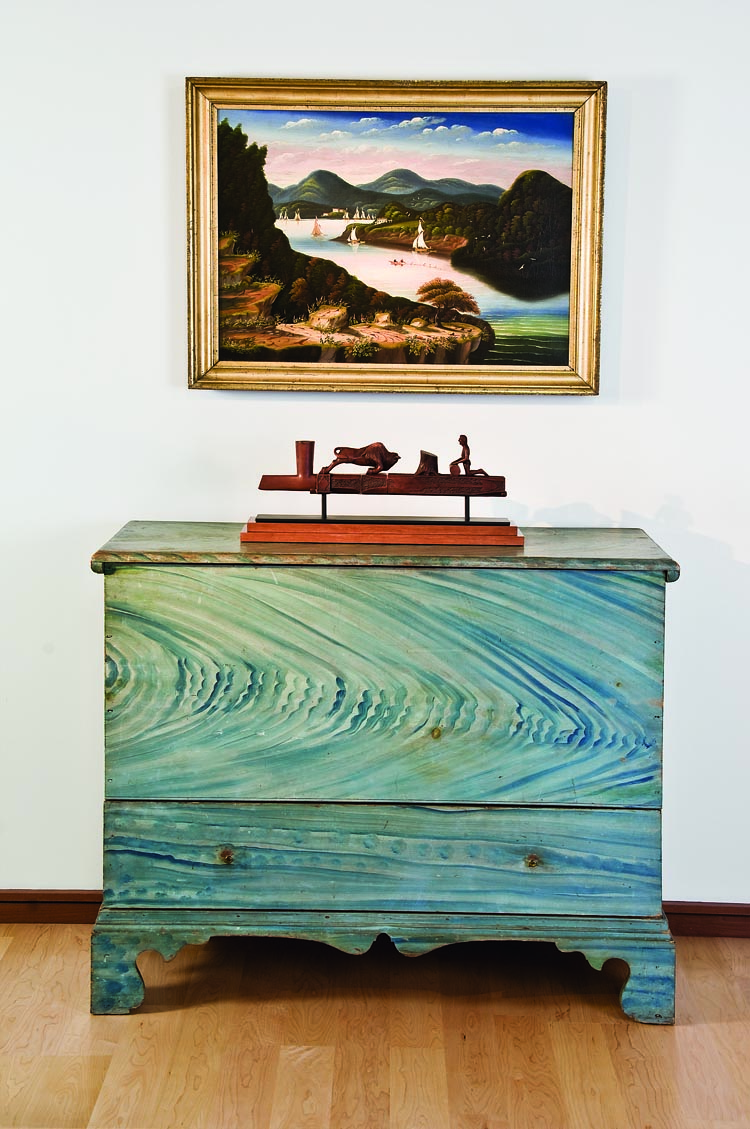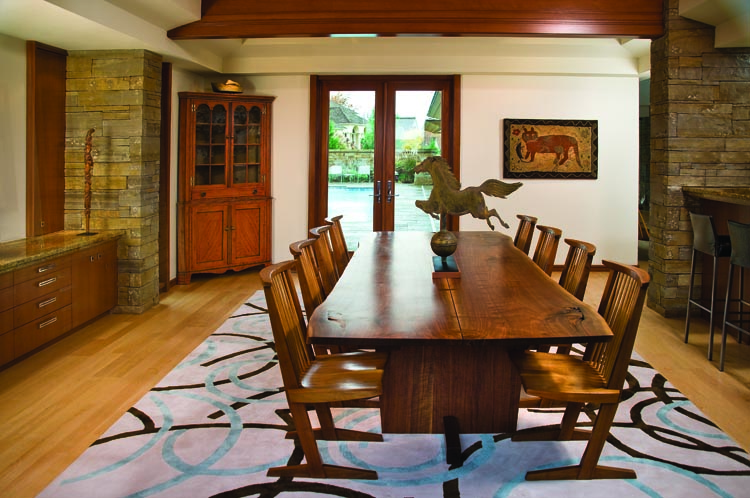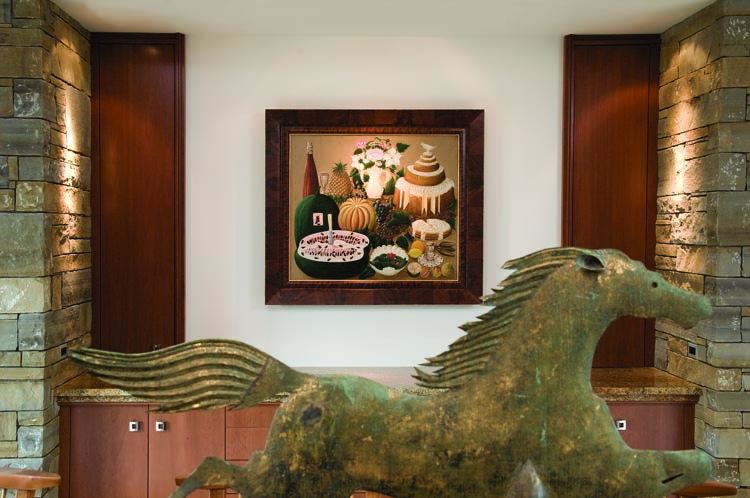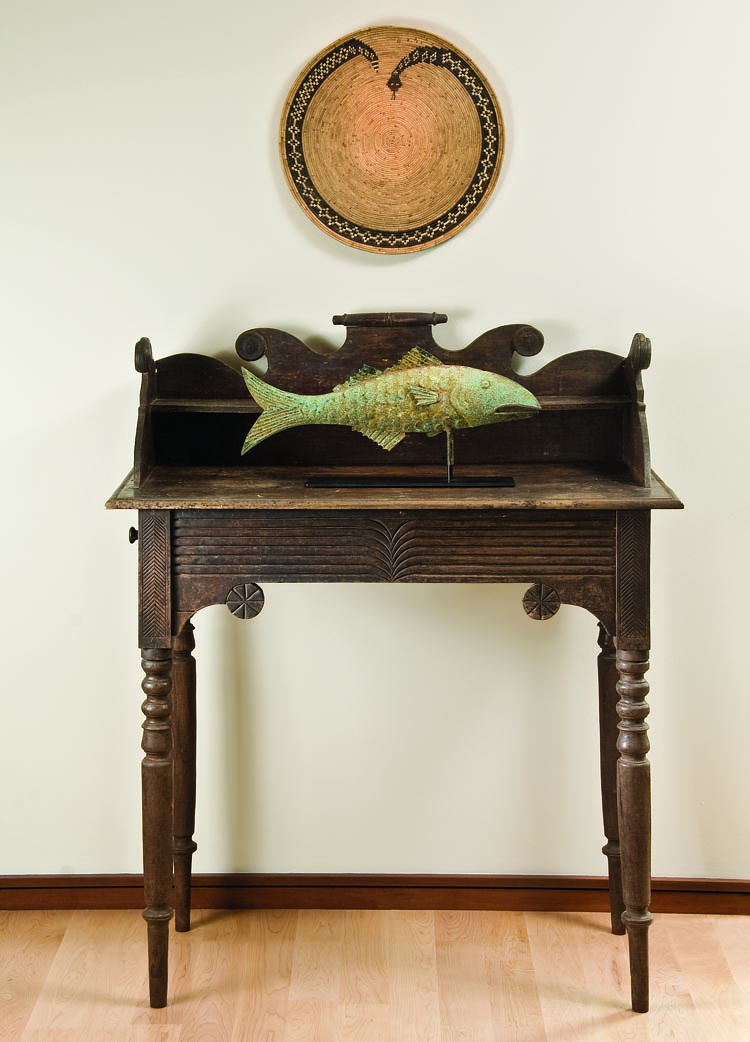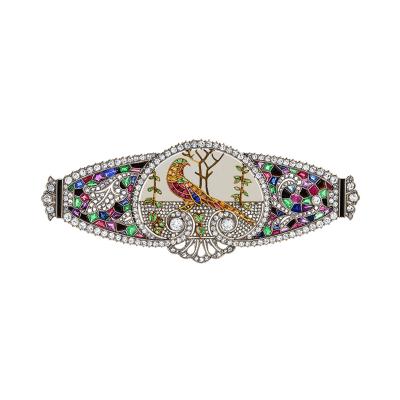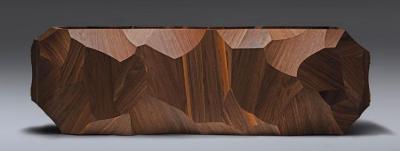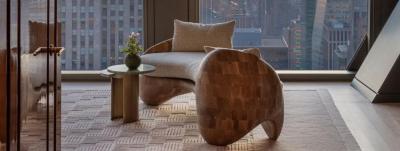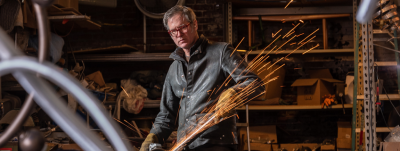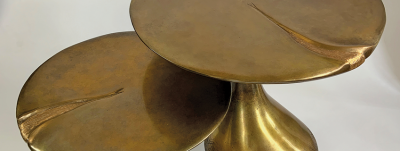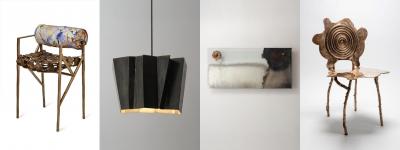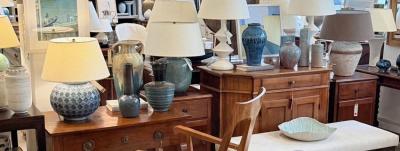The Dynamics of Collecting

- The view looking into the dining room from the living room holds a number of key pieces. In the foreground is a rare circa-1865 Centaur weathervane made by A. L. Jewell & Company of Waltham, Massachusetts. Beyond it is a bench made by George Nakashima (1905–1990). A circa-1870 trade figure in the form of an Indian maiden stands outside the entrance to the dining room. It is attributed to Julius Melcher (1829–1909) of Detroit, Michigan. Distinctive of his work is the detail of the hair, headdress, carved floral belt, the folds in the sleeves, and the style of the shoes. A table by Mira Nakashima-Yarnall (b. 1942) and chairs by her father, George, fill the dining room. An A. L. Jewell flying horse weathervane, one of the great folk art forms, and rooster by Cushing & White of Waltham are two of the vanes in the room. Says folk art dealer Fred Giampietro of the latter, “It is a great example, perhaps the best I have ever seen. It has great presence.” Owner Bob Alexander concurs when he says, “It is my favorite form of rooster weathervane.”
“It’s a dynamic collection,” says Becky Alexander. “We buy, we sell. If the house becomes too cluttered then it is time to start culling.” She adds, “Over the years we have probably sold more than one hundred pieces.” While it seems a substantial amount of material has left their hands, Bob and Becky Alexander have been actively building their collection for over twenty years and take collecting very seriously. As Bob energetically notes, “When we go to a show we’ll be the first in line.” Adding with a smile, “At the gala opening at New York’s Winter Antiques Show in January, executive director Catherine Sweeney Singer will even bring us refreshments.”
Even though the couple has embraced collecting for nearly a quarter century, folk art dealer Fred Giampietro, who has been working with the Alexanders since the 1980s, says, “There is a spontaneous feel to the collection.” This in part may have to do with the couple’s interest in combining period folk art with modern design and allowing each object or work of art to have its own sense of space. As Becky notes, “We have always been attracted to a certain look and want to create a showcase for each piece.” Adds Fred, “Their collection explores the full range of material: paintings, carvings, pottery, decoys, painted and decorated furniture, weathervanes, and Native American. It is this tremendous range that gives the collection breadth, balance, and impact.”
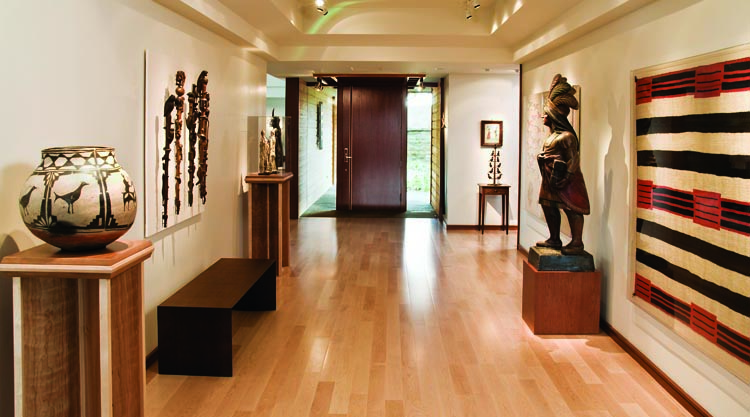
- When visitors enter the Alexander’s home their first vision is of the front hallway. To the right is a folk art group consisting of a grained table on which is placed a Pennsylvania bird tree with a turtle base, attributed to Steven Deady, an Illinois shoemaker. On the wall behind is a birth and baptismal fraktur decorated by Reverend Henry Young. A pre-painted scene, Young apparently filled in the text for each client. The text for this example is for Moses Stover, son of Mr. Samuel and wife Catharine Stover, Haines Township, Center County, Pennsylvania, 1852.
The hallway is set up as a gallery with the material either representing or crafted by Native Americans. On the right is a carved and painted trade figure signed by Samuel Anderson Robb (1851–1928) of New York City. Robb was one of the most prolific carvers of his time. In addition to trade figures, he made circus wagons and signs. This is perhaps the best preserved and documented example of the form by Robb. Beside the figure is a phase II Navajo Chief’s blanket dating between 1850 and 1860. It is rare to find one in such good condition because they were worn and used as trade goods. On the opposite wall are two unusually large and detailed male and female Sioux dolls made for the tourist trade, circa 1890s to 1900. A group of Chippewa walking sticks are displayed as sculpture. In the left foreground is a circa-1880 storage jar from either the Cochiti or Santo Domingo tribe in New Mexico.
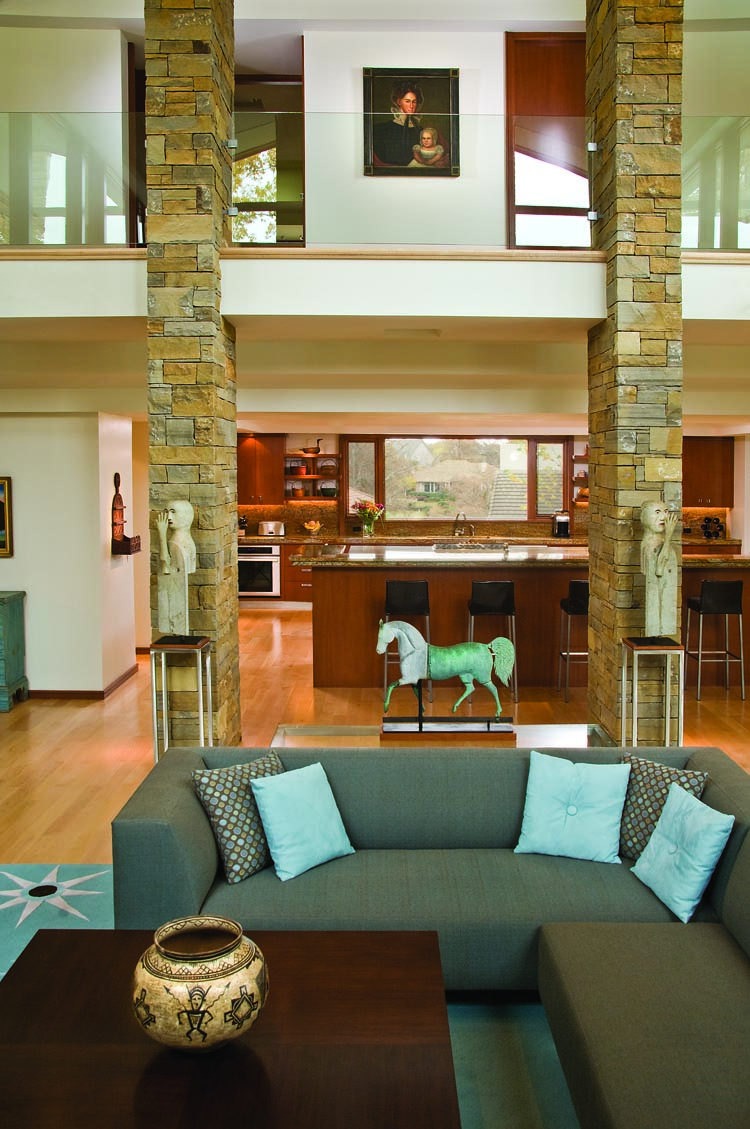
- The living room is bathed in light from two floors of windows. Custom-designed lights string across the room along the outer edges, brightening the space at night. The stone interior chimney extends from floor to ceiling. An Indian warrior weathervane in the form of Massasoit, is mounted on the mantel above the fireplace. It is a one-of-a-kind hand-made piece, unlike the more typical factory-made weathervanes of the period. From this view, the space given each object is evident, with the intention of highlighting the individuality of every piece in the collection.
Like most collectors, an interest in acquiring “things” began at an early age for Bob. “I have always collected. Like most boys I had collections of coins and baseball cards.” As newlyweds, Bob and Becky first centered on advertising art and trade signs. When they acquired their first cigar store figure the focus of their collection started to shift. “The figures overlap with folk art,” says Bob, “and we gravitated naturally into this area of collecting.” They soon recognized that much of the iconography of advertising material also transfers to and is frequently seen as folk art.
“We met Fred Giampietro at an antiques show right at the beginning of when we started buying folk art,” says Bob. “Through the years, he has helped us to acquire better and better material as our tastes matured and we were able to stretch into higher categories.” Though much of the collection came from Fred and has never been seen publicly, Bob says, “Fred has also found great objects through other dealers, calling us if he spots something at an antiques show.” Recognizing the important role a dealer plays in forming a strong collection, the couple note the trust gained by working together. They both agree, “The dealer has to have respect for what collectors are looking for and what they are ready for at a certain time.”
“Bob and Becky are a long way from where they began,” states Fred. “As the collection has matured, we have analyzed every acquisition, making sure it will improve it.” He adds, “As the collection grows, so do the collectors.” The dealer notes that the couple’s collecting has not been casual and points to how their sense of taste and quality has developed over time. “When you look at their collection piece by piece,” says Fred, “you see that each object represents the best of its kind, and all with great provenance and originality.” Fred credits the Alexanders for taking their time over the years and not rushing into purchasing an object to fill a space. “They have been very particular about what they buy,” he notes. “A collector needs to have an understanding,” says Bob, “that not everything comes quickly and that often you need to wait if something isn’t exactly what you want, no matter how tempted you may be to acquire a form that you have been searching for.”
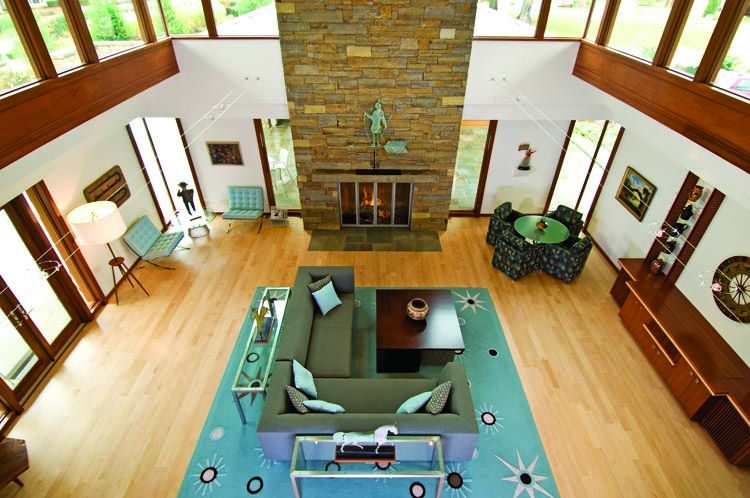
- With the grand stone chimney behind the viewer, one looks toward the kitchen to see, in the foreground, a Native American Cochiti tribe ceremonial pot showing weather iconography. This early New Mexican example dates to the 1840s-50s. A prancing horse weathervane by J. Howard of Bridgewater, Massachusetts, circa 1860, is set between squared stone columns. On the far side of the left column is an unusually large eighteenth-century spoon rack in original red paint, from the Hudson River Valley. In addition to its scale, it is embellished with complex pinwheel and carved patterns. Overlooking the balcony of the second floor is a painting of a mother and child attributed to Zedekiah Belknap (1781–1858).
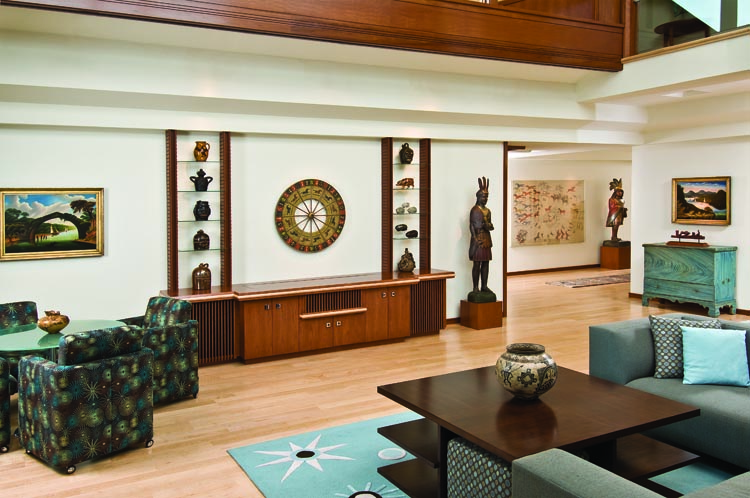
- So as not to interrupt the aesthetics of the interior, modern conveniences are hidden from view. When not in use, the television sinks into the floor and disappears beneath the counter.
Centered on the wall is a paint-decorated roulette wheel, circa 1880s. Each quadrant features an image and name of a famous race horse. Flanking the wheel are shelves that hold the couple’s collection of ceramics. Displayed on the shelves to the right is a slave-made face jug from Edgeville, South Carolina. “Most of the time these have a cartoonish appearance,” says Bob, “but this one seems more realistic, as if it might be a self-portrait.”; Anna pottery presentation pigs from Illinois are from the 1880s and feature railroad lines; an Anna Pottery snake jug depicts a bar room brawl during the Civil War. This jug is from the Barry Cohen collection and was an early acquisition of the Alexanders. On the left is a circa 1815 redware pitcher from Clinton Pottery, Clinton, New York, signed “Clinton/Ware” along the sides. Each side also features an eagle; A circa-1900 devil jug was made in Georgia and is attributed to “D.X. Gordy.”; the Pennsylvania face jug pitcher appears to be a portrait of an African American soldier in the Civil War, evident by the Kepi hat he wears; a group of liquor jugs are from Fort Smith, Arkansas, an unruly area much like the wild west. During the peak of its lawlessness, Federal judge Isaac Parker sentenced more men to be hung than anyone else in the country: Of the 160 men given this death sentence, eighty-eight were executed.
At each end of this room hangs a pair of landscape folk art paintings by Thomas Chambers (ca. 1808–1866). They depict a continuous stretch of a waterway with an oxbow bend. The pair descended through a New England family. In the hallway beyond is a Native American 1880s painting on muslin that depicts Sioux stealing horses from Crow Indians. When on the reservations, Native Americans were encouraged to draw images from their memories
The methodical manner in which they have approached their collecting has carried over into the thoughtfulness they put into designing their present home. When they moved back to Arkansas from Texas in 1987, the couple lived in a Colonial-style house. When they retired nearly twenty years later, Bob and Becky decided to build a new house. They consulted with the local architectural firm Maurice Jennings+David McKee. Both had worked with Frank Lloyd Wright-trained E. Fay Jones, and Jennings had been Jones' business partner. “We chose to work with the firm because we wanted a Prairie-style home, an aesthetic that is both historic and still considered modern.” Clarifying, Bob states, “We prefer the classic modern look to the industrial modern style.”
“Jennings and McKee are known for designing structures with stone floors and walls, and lots of glass windows. We needed wall space for hanging paintings so they had to rethink their approach,” says Bob. Adds Becky, “We reviewed our collection with the architects to determine where things would go, knowing, however, that we would continue to make more purchases. “We gave them dimensions of the works we knew we wanted to keep,” she says, “so that they could lay out the house for particular pieces.” This communication is perhaps most evident with the still life in the dining room for which the architects designed a receding alcove to frame the painting. As a result, the work anchors the room. “We spent thirteen months working on the planning before we broke ground,” Becky recalls.
The house took two years to build and was finished in 2008. Attention was focused on detail. “The architects, and builder Neal Hefner, were very hands-on in working with us, overseeing the entire project,” says Bob. “Nothing was bought off the shelves, everything was made to order.” In addition, the couple built the house with the environment in mind. This included the requirement that nothing would off-gas, which meant supplies such as paint and wood had to have low VOC (volatile organic compounds) emissions. Lighting, heating, and cooling systems are also state-of-the-art in energy efficiency. Careful selection was also given to the type of materials used on the exterior, leading to cypress siding, which is weather and insect resistant. “By building green,” the couple says, “We probably spent fifty percent more, but the house is a healthy place to live.” The structure of the house was only one component. The finish work was also meticulous, with great care going into the design and construction of the interior. The result is an aesthetically striking home that showcases the art within.
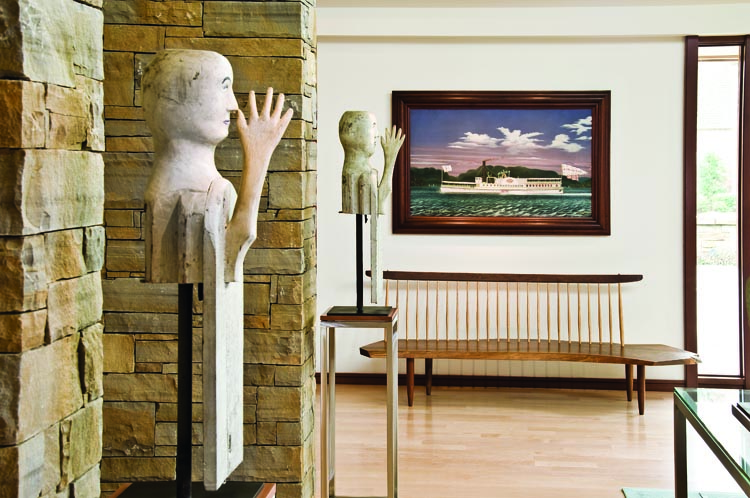
- These ghostly white forms are actually circa 1900 to 1910 carnival ring toss figures, seemingly thumbing their noses at the players. They are illustrated by Ricco/Maresca in American Primitive. Says Fred, “The maker had a wonderful sense of humor.”On the wall beyond is a large painting of the paddle boat Nantasket, identified in the lower left corner as being “Built by Thomas Collyer/ NY 1857.” The artist signed and dated the painting in the opposite corner: “Drawn & Painted by James Bard N.Y./ 162 Perry Street/1858.” Below the painting is a bench dated June 19, 1987 and signed by George Nakashima (1905–1990).
The work of one family of furniture makers in particular shines within this Prairie-style home—that of George and Mira Nakashima. “Even if you don’t know anything about collecting,” says Bob, “one can be drawn to the art of the Nakashimas.” Their sleek lines, natural forms, and craftsmanship complement the craft sensibility of the home. The work of George (1905–1990), the father, is represented by of a bench in the living room and a set of chairs in the dining room. His daughter, Mira Nakashima-Yarnall (b. 1942), made the couple’s dining table. “With the Nakashima [chairs and bench],” says Becky, “the effect is of a modern Windsor. The simple, yet robust forms allow each surrounding piece to be visually strong.”
The folk art, paintings, and period furniture all shine within their relatively new home. Among the couple’s favorite pieces are those in the living room, with its blue color scheme that picks up the same tones from the art shown in the large open space. A favorite of Bob, Becky, and Fred’s is an oversized Civil War-era game board with a snake trail. In addition to the size of the game board, whimsical figures, and captions punctuate the playing surface. Becky also favors the paintings, particularly that of the paddle boat Nantasket by James Bard (1815–1897), which hangs above the Nakashima bench, and the still life of fruit in the dining room. “I love the whimsy [of the latter],” she says. Three of Bob’s favorites include the circa 1900 to 1910 carnival nose thumbers, designed to catch tossed rings on their hands; the petite Liberty weathervane; and the Native American muslin painting in the hallway.
Though they have continued to upgrade, a number of the couple’s first purchases remain in their collection. In the hallway a store trade figure carved by Samuel Anderson Robb (1851–1928) of New York City was the first example they acquired. “It retains the best original coat of paint of any Robb trade figure I’ve seen,” says Fred. “It has never seen the out of doors and therefore has never needed to be repainted.” He adds, “This one must have been used inside, perhaps in a hotel. It’s a time capsule,” he says. The couple also retains their first weathervane, the circa 1860 flying horse made by A. L. Jewell & Company, Waltham, Massachusetts, which now graces the Mira Nakashima-Yarnall dining table.
With the new year Bob and Becky await the coming season of antiques shows. They will surely be waiting in line, ready to discover the next object or artwork that will enter their collection.
This article was originally published in the 10th Anniversary issue of Antiques & Fine Art magazine, a fully digitized version of which is on afamag.com. AFA is affiliated with Incollect.com.


